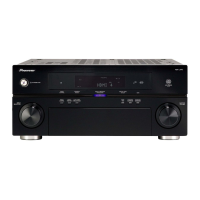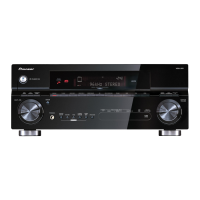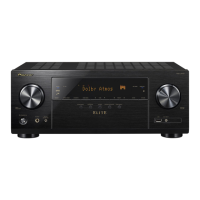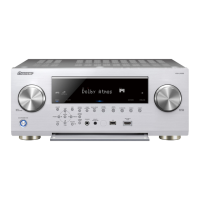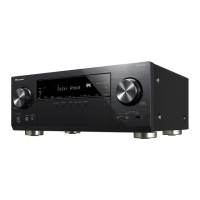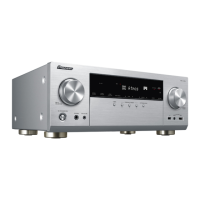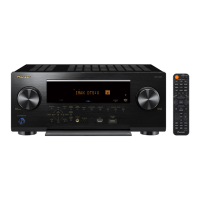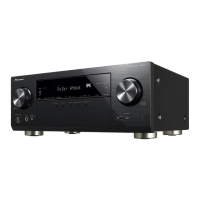Do you have a question about the Pioneer VSX-LX60 and is the answer not in the manual?
Verify the supplied accessories included with the Pioneer receiver for proper setup and operation.
Guidelines for correctly placing the Pioneer receiver to ensure optimal performance and safety.
Explains the concept of home theater and surround sound effects created by multi-channel audio.
Quick guide to connecting speakers and setting up for surround sound using default settings.
Detailed steps for using the MCACC system to automatically optimize speaker settings and room acoustics.
Identifies and describes various input and output terminals located on the rear panel of the receiver.
Instructions for connecting HDMI-compatible devices for high-quality audio and video.
Explains how to connect video sources using component video cables for superior picture quality.
Detailed description of buttons and indicators on the receiver's front panel for operation.
Guide to using the remote control, including its buttons and operating range for controlling the receiver.
Guidelines for correctly placing the Pioneer receiver to ensure optimal performance and safety.
Instructions for inserting batteries into the remote control unit, with important safety precautions.
Explains the concept of home theater and surround sound effects created by multi-channel audio.
Step-by-step guide to connecting speakers and setting up for surround sound quickly.
Detailed steps for using the MCACC system to automatically optimize speaker settings and room acoustics.
Step-by-step instructions for running the MCACC automatic setup process for surround sound.
Common problems encountered during Auto MCACC setup and their solutions.
Basic instructions on selecting and playing audio sources using the receiver's input selector.
Guide on selecting playback modes like Auto Surround and Stream Direct for audio sources.
Explanation of Phase Control and Full Band Phase Control features for enhanced audio clarity.
Instructions on how to activate and use the Phase Control function for better bass response.
Details on Full Band Phase Control for calibrating speaker frequency-phase characteristics.
Steps to enable the Full Band Phase Control feature for improved surround sound integration.
Overview of all input/output terminals on the receiver's rear panel.
Instructions for connecting HDMI-compatible devices for high-quality audio and video.
Guidance on connecting digital audio sources using optical and coaxial inputs.
Explains how to connect video sources using component video cables for superior picture quality.
Details on connecting various audio/visual sources like DVD players, VCRs, and other video devices.
Instructions for connecting sources with multichannel analog outputs, such as DVD players.
Guide on connecting front, center, surround, and surround back speakers to the receiver.
Basic setup guide for connecting a TV and a DVD player to the receiver.
Instructions for connecting a Blu-ray disc player to the receiver for audio and video.
Guide for connecting set-top boxes like satellite or cable receivers to the receiver.
How to connect DVD/HDD recorders, VCRs, and other analog/digital video sources.
Explanation of component video connections for superior picture quality compared to composite.
Instructions for connecting digital audio components for playback and recording.
Details on the built-in WMA9 Pro decoder and its playback capabilities with compatible sources.
Guide for connecting analog audio sources, including turntables and tape decks.
Using the convenient front panel inputs for portable equipment like camcorders and video games.
Comprehensive guide to connecting and installing various speaker configurations for surround sound.
Specifics on connecting speaker wires to the receiver's terminals, ensuring correct polarity.
Instructions for connecting AM and FM antennas for optimal radio reception.
Tips and recommendations for placing speakers for the best surround sound effect.
Detailed advice on speaker positioning to achieve the best possible surround sound quality.
Visual guides showing suggested surround and surround back speaker orientations.
Instructions for connecting AM loop and FM wire antennas for radio reception.
Guidance on connecting FM antennas for improved reception quality.
Steps for safely connecting the receiver to power and using the switched AC power outlet.
Identification and basic function of controls on the receiver's front panel.
Instructions on using the INPUT SELECTOR dial to choose an input source.
Functionality of the STANDBY/ON button and power indicator light.
Explanation of buttons used to select various listening modes like HOME THX and STANDARD SURROUND.
Description of the MASTER VOLUME dial for adjusting audio playback levels.
Information on factors affecting the remote control's performance and operating range.
Explanation of the various signal, format, and listening mode indicators on the receiver's display.
Lights indicating the currently selected input signal and AUTO signal selection.
Indicators showing active channels in digital sources (e.g., L, C, R, SL, SBR).
Overview of the remote control's buttons and color-coded systems for component control.
Instructions on using input source buttons to select components or receiver functions.
Explanation of remote buttons dedicated to receiver functions like SLEEP, DIMMER, and ANALOG ATT.
Dedicated remote buttons for controlling a assigned TV.
Using main buttons to control components after selecting their input source.
Functions of the MULTI OPE button for multi-operations and RECEIVER button for system control.
Using the Auto Surround feature for automatic source detection and playback mode selection.
Guide to experiencing surround sound with various sources and speaker setups.
Description of basic surround sound modes for stereo and multichannel sources.
Explanation of THX modes for cinema-quality sound and optimal home theater audio experience.
Exploring various Advanced Surround modes for additional surround sound effects.
How to select STEREO mode and use its functions for playback through front speakers.
Using Front Stage Surround Advance for natural surround effects using front speakers.
Using Stream Direct modes to bypass signal processing for pure analog or digital sound.
Switching between calibrated MCACC presets for different listening positions or sources.
Selecting the correct input signal (AUTO, ANALOG, DIGITAL, HDMI) for connected components.
Configuring settings for surround back channels to enhance 6.1 or 7.1 channel playback.
Creating a virtual surround back channel through surround speakers when none are connected.
Automatically selecting Advanced Surround mode based on the source's genre for synchronized playback.
Connecting and using USB mass storage devices for audio playback.
Overview of remote control buttons for managing USB playback functions.
Navigating and selecting audio files from the folder/file list on a connected USB device.
Steps for selecting and playing back files from a USB device, including error handling.
Information on compatible compressed audio formats and potential playback issues.
Information regarding the Windows Media Audio (WMA) format and its compatibility.
Guide to tuning FM and AM radio stations using automatic and manual tuning functions.
Instructions for directly tuning to a radio station using frequency entry.
How to memorize and recall radio stations by saving them as presets.
Procedure for assigning custom names to saved radio station presets for easier identification.
Instructions on how to select and listen to previously saved radio station presets.
Introduction to Radio Data System (RDS) and its features, including program type search.
How to search for radio programs based on specific program types using RDS.
Viewing different types of RDS information such as PS, RT, and PTY.
Activating EON to automatically tune into traffic or news broadcasts.
Overview of accessing and navigating the System Setup menu for detailed receiver configuration.
Advanced MCACC setup options for detailed customization of speaker and room acoustics.
Step-by-step guide for performing the advanced MCACC setup with custom options.
Instructions for connecting the MCACC setup microphone and ensuring proper placement.
Verifying the detected speaker setup on the OSD and making corrections if necessary.
Setting options for using surround back speaker terminals (Normal, Speaker B, Bi-Amp, ZONE 2).
Using manual settings to fine-tune speaker parameters after initial MCACC setup.
Overview of manual MCACC adjustments including Fine Channel Level, Speaker Distance, and EQ.
Fine-tuning speaker channel levels using test tones for optimal balance.
Setting speaker distances precisely for optimal sound depth and separation.
Reducing unwanted resonant ('boomy') sounds in the listening area using frequency filters.
Manually adjusting room equalization for speakers to achieve a preferred frequency balance.
Advanced EQ setup minimizing room reverberation effects for optimal system calibration.
Analyzing room acoustics and frequency response for advanced sound calibration.
Calibrating speaker frequency-phase characteristics to correct group delay and improve sound.
Measuring and displaying room reverb characteristics for calibration analysis.
Performing measurement for Full Band Phase Control to calibrate speaker characteristics.
Managing MCACC presets: checking, renaming, copying, and clearing calibration data.
Viewing saved MCACC settings for different listening positions or sources.
Copying and clearing MCACC preset data for efficient calibration management.
Assigning custom names to MCACC presets for easier identification and organization.
Detailed manual configuration of speaker settings for optimal surround sound.
Specifying speaker size, number, and crossover frequency for each speaker.
Adjusting individual speaker channel levels for optimal system balance using test tones.
Precise adjustment of speaker distances for optimal sound depth and separation.
Adjusting the X-Curve to restore proper tonal balance of movie soundtracks.
Configuring THX audio settings for optimal results with THX Select2 Cinema and MusicMode.
Instructions for connecting an iPod to the receiver for audio playback and control.
Using the receiver and TV display to navigate and play music from your iPod.
Basic playback controls for managing music playback from a connected iPod.
Guide to connecting HDMI or DVI-equipped components for high-definition audio/video.
Detailed instructions for connecting HDMI components and understanding HDMI Control.
Connecting sources with multichannel analog outputs for surround sound playback.
Selecting the correct input source for multichannel analog audio playback.
Configuring the surround back terminals for use as a separate stereo system (Speaker B).
How to switch between the main speaker system (A) and Speaker B system.
Options for using Speaker B terminals for stereo playback or other zone setups.
Instructions for bi-amping front speakers for improved crossover performance.
Guide to bi-wiring speakers for potentially reduced interference and better sound.
Adding external amplifiers to power speakers or create multi-channel setups.
Configuring the receiver for multi-zone audio playback in separate rooms.
Steps for connecting separate amplifiers and TVs for primary and secondary sub zones.
Table outlining available input sources for ZONE 2 and ZONE 3 sub zones.
Connecting amplifier and TV for the basic ZONE 2 setup.
Connecting an amplifier to the OUT1 ZONE3 digital output for a second sub zone.
Operating sub zone volume and selecting sources using front panel controls.
Explanation of remote control buttons used for managing MULTI-ZONE operations.
Using an optional IR receiver for controlling components in cabinets or other zones.
Connecting IR receivers to control components remotely.
Using 12 volt triggers to automatically switch components on/off with input selection.
Connecting a Pioneer plasma display for SR+ features like automatic input switching.
Enabling and configuring SR+ features for enhanced interaction with Pioneer plasma displays.
Connecting a PC to the receiver for graphical output of MCACC calibration data.
Steps for using the PC application to view and analyze MCACC calibration results.
Making connections for HDMI Control between the receiver and compatible Pioneer devices.
Configuring HDMI Control settings (ON/OFF) for synchronized operation.
Enabling or disabling the HDMI Control function for synchronized playback and input switching.
Understanding how synchronized amp mode works with HDMI connections for seamless operation.
Configuring input assignments for connected components to match remote control buttons.
Default terminal assignments for various input sources and possible changes.
Detailed input terminal assignments for digital, HDMI, component, and S-video inputs.
Accessing and navigating the Other Setup menu for customized receiver settings.
Adjusting subwoofer level and assigning video inputs for multichannel sources.
Configuring subwoofer gain and video input assignment for multichannel sources.
Setting volume levels (Variable/Fixed) for MULTI-ZONE audio playback.
Configuring SR+ features for enhanced interaction with Pioneer plasma displays.
Setting receiver volume control for the plasma display (ON/OFF).
Adjusting the position of the on-screen display (OSD) for optimal visibility on your TV.
Configuring various audio settings like Tone Control, S.RTRV, DNR, MCACC presets, and EQ.
Adjusting LFE levels and SACD gain for optimal audio output and dynamic range.
Adjusting video settings like Resolution, Aspect Ratio, Brightness, Contrast, and Hue.
Configuring video output resolution (RES) and aspect ratio (ASP) for connected displays.
Instructions for recording audio or video from tuner or connected sources.
Listening to a different source while a recording is in progress.
Selecting the source for recording using the REC SELECT CONTROL button.
Using the input attenuator to lower strong analog signal levels and prevent distortion.
Setting the sleep timer to automatically turn off the receiver after a specified time.
Changing the brightness level of the front panel display using the DIMMER button.
Viewing current settings for features like MCACC, Surround Back Processing, and Zone.
Procedure to reset all receiver settings to their original factory default values.
Confirming the system reset operation to return the receiver to factory default settings.
Assigning preset codes to control external components with the receiver's remote.
Directly selecting manufacturer preset codes for controlling external components.
Teaching the remote individual commands from an existing remote control.
Resetting individual programmed remote control buttons to their factory defaults.
Procedure to erase all programmed preset codes and buttons on the remote control.
Customizing input source names displayed on the remote control LCD for easier identification.
Using the direct function to control one component while operating another via the receiver.
Programming sequences of commands for multiple components or system shutdown.
Steps to program a series of commands for multi-operation or shutdown sequences.
Starting multi-operation sequences with the receiver on or in standby.
Activating the System Off function to power down multiple components simultaneously.
Dedicated remote buttons for controlling an assigned TV.
Functions available for controlling various components like DVD players and VCRs.
Linking Pioneer components for control using a single remote sensor.
Diagnosing and resolving problems related to the receiver not turning on or switching off.
Resolving issues where no sound is output from speakers or specific channels.
Addressing issues like noise, hum, incorrect audio playback, and recording problems.
Resolving problems with no image, noisy picture, or incorrect display settings.
Addressing errors during Auto MCACC setup and incorrect speaker size settings.
Troubleshooting problems with the graphical EQ output not appearing flat or disappearing.
Resolving issues with the display being dark, off, or not showing correct information.
Resolving issues where the remote control is not working or cannot operate other components.
Diagnosing and fixing problems related to HDMI indicators, picture, sound, and HDCP errors.
Resolving issues with USB devices not being recognized or audio files not playing.
Troubleshooting iPod connection errors, software version issues, and playback problems.
Descriptions of main surround sound formats like Dolby Digital, EX, Pro Logic IIx, and Surround EX.
Explanation of Dolby Digital, Surround EX, Pro Logic IIx, and Surround formats.
Details on DTS Digital Surround, DTS-ES, DTS Neo:6, DTS 96/24, DTS-EXPRESS, and DTS-HD Master Audio.
Information on WMA9 Pro for discrete surround sound playback.
Overview of THX technologies, including THX Cinema processing for enhanced movie soundtracks.
Explanation of THX features like Re-Equalization, Timbre Matching, and Adaptive Decorrelation.
Using ASA technology for optimal surround sound with specific THX modes.
Overview of Neural Surround for detailed sound stages and superior localization.
Charts detailing listening modes available based on input signal format and SBch processing.
Table showing listening modes for stereo signals with different SBch processing and decoding.
Table showing listening modes for multichannel signals with different SBch processing.
Charts showing audio output based on input signal format and Stream Direct mode (DIRECT/PURE).
Detailed technical specifications for the receiver's amplifier, tuner, input/output, and miscellaneous sections.
Instructions for cleaning the unit safely and effectively.
Overview of Pioneer's commitment to audio quality and key receiver features.
Highlights of major features like Advanced MCACC, HOME MEDIA GALLERY, and Dolby/DTS decoding.
Explanation of DCDI Processing for smooth and natural image processing.
Information on the receiver's compatibility and features for controlling an iPod.
| Impedance | 6 Ω |
|---|---|
| Frequency range | 5 - 100000 Hz |
| RMS rated power | 260 W |
| Signal-to-Noise Ratio (SNR) | 92 dB |
| Total Harmonic Distortion (THD) | 1 % |
| HDMI | Yes |
| Audio system | DD / DTS |
| Output power | 170 W |
| Channels quantity | 7.1 channels |
| Dimensions (WxDxH) | 420 x 459 x 187 mm |
| Power requirements | 220V - 230V, 50Hz / 60Hz |
| HDMI ports quantity | 4 |
| Digital audio coaxial out | 0 |
| Digital audio optical out | 1 |
| Digital audio coaxial in | 2 |
| Digital audio optical in | 5 |
| Product color | Black |
| Power consumption (standby) | 0.6 W |
| Power consumption (typical) | 460 W |
| Weight | 17000 g |
|---|
